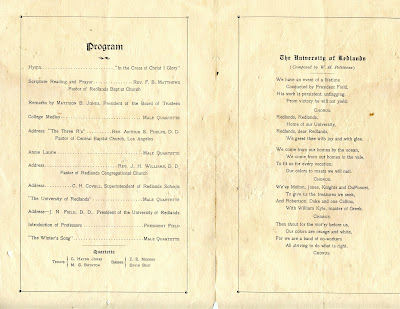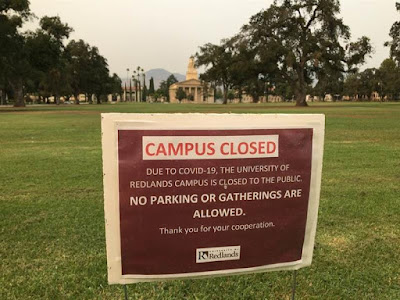When the
University of Redlands Archives was established in 2001, its mission statement emphasized
that the goal of the Archives was, first and foremost, to contribute to the
“sense of place” for those connected to the University, “by emphasizing the importance
of history and that each individual has a place within that history.”
What better
reason is there for observing American Archives Month than to celebrate that
each of us deserves to be seen -- by acknowledging our “place within that
history.” Your Archives is open to all to donate the artifacts that will
commemorate your time here, as well as being open for you to learn more about
others associated with the University. It’s a celebration of the continuity of
our “place” within this institution and our shared story. The Archives are here
to preserve materials which have been handed down from those who came before us,
from people like you who make up the U of R today, and from those who will
follow.
We who care
for the items in the University Archives organize and catalog them so that we
can easily access them for your use. Archives of any type provide an
opportunity for you to use original research called primary sources, or firsthand
facts, data, and evidence, from letters, reports, notes, memos, photographs,
audio and video recordings, and more.
The
University Archives contains more than 1,000 linear feet of collections which currently
includes more than 20,000 photographs, an almost complete run of the student
newspaper and other student publications, documentation about student life,
clubs and organizations, and Greek life, yearbooks, faculty committees, and a
collection of architectural drawings for every building on campus including the
working drawings for the Administration Building (1909) and Memorial Chapel
(1927).
One of these items is a very early pamphlet entitled, “Opening Exercises of the University of Redlands,” dated “Wednesday, September 29, 1909.” The document outlines a modest opening to the great undertaking of establishing a university. The lyrics to “The University of Redlands” song are printed within it. Sung by a male quartet, the story of our Redlands ancestors and their hope for their endeavor, was sung on that day in September,
Then shout
for the vict’ry before us,
Our colors
are orange and white,
For we are a
band of co-workers
All striving
to do what is right.
Skipping ahead 111 years to 2020, the original story continues (though our official campus colors did change!); we’re still striving. This year, in particular, we’re striving to overcome an extraordinary amount of obstacles. The Archives continues to add to the documentation of our story, for example with this image taken in August of a closure sign on the Quad.
Yes,
archives are the stewards of the dusty and yellowing stuff which seem to come
from another world, but we must also be stewards of the history being made
today. We want our authentic story, our “sense of place,” to continue for our descendants
to discover, to learn from, to be inspired by, and to enjoy.
For those
whose research goes beyond the scope of the University of Redlands Archives,
the City of Redlands offers the archives known as the Heritage Room at A.K. Smiley Public Library Special Collections. Here is also a list of samples of
online databases and archives that may also be of use:
ArchiveGrid
allows you to search by topic and receive results from over 1000 archival
repositories.
Online
Catalog of National Archives holdings.
v New York Public
Library Archives Finder
Provides
information and detailed indexing to manuscript collections from over 5,000
U.S. repositories.
v Online Archive of California
Public
access to detailed descriptions of primary source collections from more than
200 contributing institutions in California.
Teresa Letizia, University Archives



